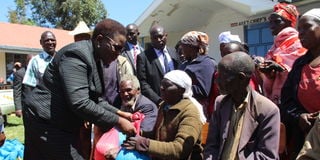40pc of Meru’s population at risk of starving due to drought

Meru governor Kawira Mwangaza gives relief food to elderly residents at Timau, Buuri sub county on 12.10.2022 in an exercise witnessed by Meru county commissioner Mr Fred Dunga.
Over 600,000 people in Meru County are in dire need of food, up from 400,000 a month ago as the effects of drought bite.
This means 40 per cent of the county’s 1.5 million people are at risk of starvation.
Schoolchildren have been hit harder, as 40 schools with over 15,000 pupils are on the verge of being closed, said County Commissioner Fred Dunga, who added that most of the children are malnourished and require special food.
“The situation is so bad that we will recommend school feeding programmers be established so that these children can go back to school because there is a lot of absenteeism,” Mr Dunga said on Wednesday.
He spoke in Kiirua and Timau in Buuri sub-county when Governor Kawira Mwangaza flagged off consignments of 440 bags of rice and 640 bags of beans to be distributed to starving residents in the semi-arid sub-county.
A committee that he will co-chair with the governor will coordinate food distribution. The team also includes representatives of area MPs and donor agencies.
“We want all food aid being brought to the county to be coordinated through this committee to avoid duplication where people who have benefited from donor assistance also get government aid,” he said.
Some food will be taken from areas that have it and taken to those in need, Mr Dunga said.
The most affected sub-counties are Buuri, Igembe Central, Igembe North and Igembe South, as well as Tigania East and Tigania West.
Some areas in Imenti Central and Imenti South are also affected.

Meru Governor Kawira Mwangaza flags off food aid at Timau, Buuri sub county on 12.10.2022 in an exercise witnessed by Meru county commissioner Mr Fred Dunga.
Last month, residents of a village in Igembe Central ate the meat of a dead camel, with119 of them falling sick and being hospitalised.
With the short rains projected to be "below average" by the meteorological department, things were bound to get worse, said Noor Godana, the Meru coordinator for the National Drought Management Authority (NDMA).
“We are at the alarm stage of this drought and we should prepare for a worsening situation with the poor rains forecast. Farmers have been advised to plant fast maturing crops because rains will not be sufficient,” he said.
Speaking during the distribution of food in Timau, Governor Mwangaza said the committee would ensure transparency and warned that administrators found to be favouring some areas or selling relief food will be dealt with according to the law.
She directed ward administrators, chiefs and area managers to ensure that all needy people were identified and food taken to them without delay.
“We are all working for the people of Meru and we will not discriminate against anybody. It doesn’t matter which party you belong to, which MP you voted for or whether you did not vote for me. All residents will benefit from this food and we will not politicise issues to do with drought,” she said.

Meru county commissioner Mr Fred Dunga speaks at Timau, Buuri sub county on October 10, 2022 when he witnessed flagging off of relief food by governor Kawira Mwangaza.
Meanwhile, water service providers in Meru have advised consumers to enhance their storage capacity to cushion themselves from increased rationing due to the dry spell.
Supply to the Meru Water and Sewerage Services (Mewass) treatment plants had dipped by half, said Patrick Mugendi, the acting CEO of the Meru Urban Water and Sanitation Services Corporation.
At normal production, the Mewass plants have a daily output of 8,500 cubic metres, serving Meru town and its environs.
Mr Mugendi said Mitunguu, which is supplied by Imetha water company, had run out of the commodity after its intake in the Thingithu river dried up.
Nkubu and Meru towns are also likely to suffer water shortages as water levels in rivers continue to decline.
“We are advising consumers to increase their storage capacity because supply is very low. In Meru town, many users rely on the pipeline and may suffer due to the rationing. We hope the situation won’t last long because it is about to rain,” he said.
Water service providers, he added, had scheduled a meeting with the Water Resources Authority (WRA) and Water Resources Users Associations (WRUA) to look into abstraction in rivers.
“There has been a challenge where many private and community projects abstract water from rivers, affecting supply during the dry season. A mini hydro project on river Kathita has also affected the flow,” he said.
He added that they were considering sinking boreholes to serve the treatment plants when river flow is unreliable.
Moses Rutere, a water expert in Meru, said water service providers need to develop sustainable technologies and infrastructure due to the effects of climate change.
“Due to climate change, it is no longer viable to rely on rivers as the primary source of water. There should be strategic water reserves as well as sources that can be relied on in the dry season. Use of check dams in rivers as well as boreholes may help when river levels go down,” Mr Rutere said.
He called for the promotion of efficient water taps among consumers, as well as reuse and recycling.






